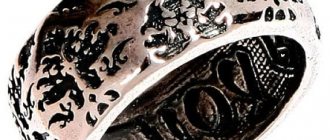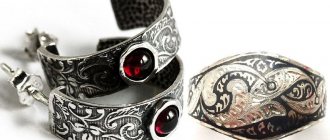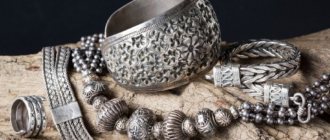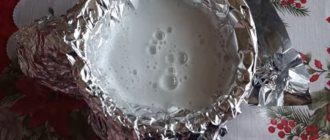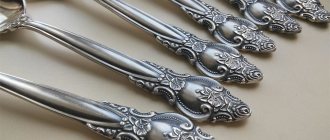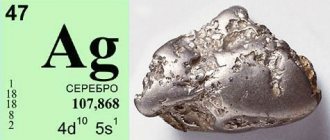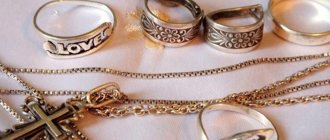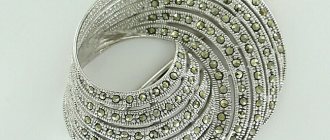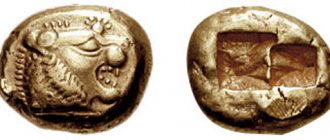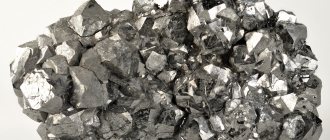Varieties of silver
Silver has a white-silver color. At the moment, the following types of this metal are distinguished: filigree, matte, blackened, coin. Each species has its own specific characteristics.
Matte silver does not have bright patterns. To obtain it, various emulsions are applied to the raw materials. The use of emulsions allows you to make the surface rough and give it additional charm. The product turns out to be original, beautiful, unusual.
Distinctive characteristics of filigree silver are a variety of openwork patterns. Since silver has high malleability and strength, thin threads are made, giving the product a beautiful and unusual design. Making filigree silver requires professionalism and takes quite a lot of time. Jewelers highlight background and openwork filigree. For an openwork look, a through pattern is implied.
Sterling silver is the main material used in jewelry. This material has a smooth surface, silver-white color, excellent strength, and a long service life. The sterling material contains 92.5% pure silver and 7.5% copper.
Oxidized and blackened silver: differences
In addition to blackened silver, oxidized noble metal is also available on the market. And it's quite difficult to tell the differences between the two unusual darkening techniques.
You may be interested in: Cost of a gram of silver: forecast for 2017
The principle of creating oxidized silver is based on coating the metal with an oxide film. It creates additional protection for the product from tarnishing, but it does not add quality or durability. After a short period of time after purchase, the item begins to fade. In order for your purchase to leave a pleasant impression, you need to take a close look at the product:
- Oxidized silver has a smooth and only slightly dark surface. Blackened silver is a rich black color that blends harmoniously with light parts.
- The patterns on blackened silver are executed very carefully.
- The cost of blackened silver is much higher than other types of this metal.
- If you clean oxidized silver, white areas will appear on it almost immediately due to friction. Blackened silver is not afraid of polishing and cleaning. Only boiling or exposure to acid can spoil the appearance of such decoration.
How is blackening applied?
There are two methods for blackening:
- Wet. The special mixture is diluted with water to the consistency of sour cream and tightly cover the decoration, pressing a little, as if pushing it in. The water evaporates, then we place the product in the oven at high temperature. The black neatly spreads over the entire surface, and we get a beautiful pattern. Then the jewelry is taken out, cooled and it is ready to delight its owners.
- Dry. The decoration is first prepared for blackening, then treated with a special solution, then the finely ground niello is poured in. They are sent to dry and into the oven at high temperature - about 300 degrees.
To melt a small decoration, use a soldering gun. The metal is heated from the reverse side of the product.
Then the product needs to be removed. This is the final step in which our decoration is filed and cleaned until the design appears. Craftsmen must do this with extreme caution, because the design is very easy to damage, and then the product can be thrown away. Then there is a stage of grinding and polishing. Canter the product as desired, apply dots or other ornaments to it.
We talked about all the intricacies of making a product with drawing, now it will be difficult to deceive you in the store, pay attention to the quality of the drawing, do not be afraid to look closely at the product.
Blackening technology
Since ancient times, craftsmen have tried to decorate their products (weapons, jewelry, dishes) with ornaments, drawings, and unusual patterns. Technologies for applying ornaments have changed and improved. Blackened silver is produced using a special technology. It is used in the processing of jewelry, as well as in applied arts. In Rus', blackening has developed since the mid-20th century. Unique rings made of blackened silver, made by craftsmen from Veliky Ustyug (Vologda region), were in demand. In the 18th and 19th centuries, dishes, cigarette cases, and trays were made using a similar technology. Master jewelers mastered numerous subtleties of the craft, but they did not pass on their knowledge, and therefore some of the nuances were lost. Blackened silver was quite expensive, so only wealthy people could afford such products. The essence of blackening was to coat pure metal with black. The product became embossed and acquired a refined appearance.
Silver blackening: what is the essence of the process. Popularity of aristocratic blackened silver in the 17th century
Blackening or patination of silver is a type of decorative and applied art that appeared among the Russian people in the 17th century. The process of this type of creativity originated in the city of Veliky Ustyug, where craftsmen working with precious metals lived.
The reason for this was the geographical location of the city of Veliky Ustyug. Once upon a time, all trade routes from west to east and back passed through it. Valuable goods and precious metal passed through this city.
Naturally, craftsmen quickly realized that they could make good money in this business. This is how the silver craft appeared, which turned from a way of earning money into an art. Almost every master could perform the technique of blackening silver products, and he did it by hand.
Entire dynasties of ink makers appeared who did not reveal the secret of silver processing technology and passed it on only to their descendants. Because of this, the silver-blue fishery almost disappeared completely.
Almost all silver items were blackened: dishes, from spoons to vases; snuff boxes; caskets; engravings. More experienced craftsmen of Veliky Ustyug could use this technique to produce paintings and icons.
Silver products subjected to the blackening procedure today represent historical heritage and works of art. Rare specimens from the 17th century have survived to this day. They can only be found in antique stores, jewelry stores, and museums.
In addition, archaeological excavations indicate that blackened silver products were made by ancient people thousands of years ago.
On the modern territory of Kievan Rus, researchers find moon earrings, bracelets, and pendants with niello, the date of manufacture of which is the 10th century. European craftsmen engraved blackened images – portraits and landscapes – on silver sheets. Asian peoples decorated weapons, jewelry, and household items with niello, such as boxes, combs, hairpins, and mirrors.
Silver bracelet
Features of blackening
This technology is aimed at obtaining unusual patterns on the product. A special technology has been developed that produces blackened silver at home. First, the jewelry is engraved or minted, then a special solution is applied to it, including oxides of lead, copper, and silver. The surface of the product must be clean; all grease stains must first be removed from it. To melt the solution, the product is heated. As a result, a beautiful black pattern appears on the silver surface.
Methods for making niello
As already mentioned, folk craftsmen began blackening precious metal more than 3 centuries ago. To this day, niello is one of the classic ways of decorating items made of precious metals. Using this method, silver jewelry is given a black color and all its various shades. Thanks to the niello, the product acquires noble and contrasting outlines. Blackening also helps to hide some defects, for example, seam connections on a ring or bracelet. In addition, blackening makes silver jewelry strong and durable.
Jewelry with a flat surface is not blackened. First, engraving is done on the jewelry, and original designs with indentations are applied. It is into these recesses that the niello is subsequently fused. Engraving depth: approximately 3 mm.
In turn, niello is an alloy that consists of copper, silver, sulfur and lead. These metals are melted down and applied in liquid form to the surface of the jewelry. Heated metals form a chemical reaction. As a result of the reaction, the drawings and patterns become black, and the precious metal itself successfully contrasts with it.
The main methods for producing alloys for blackening:
German
Copper and silver are melted, the entire composition is constantly stirred when heated. Molten lead is poured into it. Then the finished composition must be mixed with preheated sulfur powder. It is important to constantly stir the alloy. Thanks to stirring, all the metals that make up the alloy react perfectly chemically with each other.
Sulfur granules
Blackened silver, characteristics, features, how it differs
In nature, silver is not a hard metal and does not have strength; moreover, it tends to darken. Since ancient times, jewelers have learned to transform this precious metal in various ways, as well as to give it strength and hardness. This is how the concept of blackened silver appeared . This method appeared before our era, around the 5th century. Ancient craftsmen introduced variety into jewelry production, and it finds interest among connoisseurs of blackened silver.
Traditional blackening (niello)
Briefly, the essence of traditional blackening (English blackening, blackened silver, historically - niello, Italian niello, from Latin nigellus, diminutive from niger - black) is this: a “black” alloy of silver, copper, lead and sulfur is smelted into the base metal . The alloy for blackening is melted into recesses (approximately 0.3 mm) formed by one of the methods of your choice - engraving, chasing, etching the product or gouging. When heated, a chemical reaction occurs between the silver and the melted mixture. As a result, in addition to new decorative properties, the blackened product also receives practical ones: it does not fade and does not require special care. The palette of niello is wide - from silver-gray to black-velvet tones.
Niello is very beautiful both on high-grade gold and on silver (for example, blackened works using the niello technique by the Italian jeweler Gigi Mariani). On copper, low-grade silver, and brass, the niello crumbles and falls off. However, it is extremely difficult to produce a high-quality, “non-flying” composition of niello for gold, which is why niello on this noble metal is rare. In common practice since ancient times, silver blackening is most often used - elegant and durable. Well, what if you still want gold? By protecting the areas with ready-made niello with a special varnish, you can gild the silver - which is not a solution!
Traditional silver blackening techniques
Perhaps the technique of blackening metals is similar to the champlevé enamel technique. But, unlike store-bought enamel compositions, you need to prepare the black one yourself (and immediately apply and fire it).
Factory galvanization is everyday life of modern technology, but not so long ago the methods of blackening silver were different. Let's mention three:
- so-called Germanic
- pre-revolutionary Russian and
- modern Moscow
In the “Germanic” recipe, lead is slowly poured into the copper-silver alloy, stirring well. The ternary alloy is poured into heated sulfur powder with constant stirring, stirring to ensure good interaction of the parts. Then the mixture is poured into water. The frozen pieces of niello are finely ground in a porcelain mortar in the required dose - only fresh, wet niello mass can be applied to the product.
According to the “Russian” recipe, the ternary alloy is not poured into sulfur powder, but sulfur is added to the alloy in portions, after which the finished niello is poured not into water, but into a cast-iron frying pan. This solid “pancake” is crushed into pieces and melted again with the addition of sulfur and flux. And so on up to three times, if you need extra-class rabble. The finished mobile is pounded in mortars and sifted through a fine sieve.
The third is the author’s recipe of Professor A. G. Spassky (Moscow Institute of Non-Ferrous Metals); prepare silver sulfide, copper sulfide and lead sulfide separately and alloy them together in the required proportions. Then they melt and cool in a strictly defined way.
Methods of applying niello
Textbooks for jewelers (for example, “Technology of jewelry production, V.P. Lugovoy, 2013) tell that there are two ways to apply niello - dry and wet. When dry , the surface is moistened with the necessary solution and finely ground black powder is applied. Carefully dry, fire in a muffle (300-400 ° C). With the wet method, the composition is applied in the form of a creamy slurry diluted with water. The mixture is applied thickly and tightly into the recesses with a brush or spatula. Waiting for the water to evaporate. Afterwards, when heated in the muffle, the niello softens, melts, flows into the design and covers the object. This is a sign to remove the item from the stove. Small decorations can be melted with a soldering gun. The heat flow is concentrated on the base metal, and it is better to heat it from the reverse side. When the mass melts, heating is completed.
Now the product is “cleaned up” by scraping or filing with a file (“removal”) until a pattern appears. The main thing is not to grab or cut down the ornament itself. Then the product is ground and polished, revealing the entire pattern. Often the background of the object is additionally engraved or shot (shotting is the application of dots, strokes or notches on the surface of the metal).
Benefits of blackened silver
Such products have numerous advantages. This material does not require additional cleaning and retains its aesthetic appearance. Such an alloy also has certain limitations. Boiling with soda, for example, removes blackening. Dishes created using this technology have long been used to store valuables, amulets, and elixirs. In ancient times, the bactericidal properties of blackened silver were considered a manifestation of magic. People sincerely believed that blackened silver protected against failure and evil spirits.
Metal oxidation
Currently, many products similar to natural blackening are made using oxidation. Today it is difficult to buy real blackened silver. The jewelry offered on jewelry store shelves is mostly created by coating a silver item with a thin oxide film. Over time, it wears off and the jewelry loses its shine. Real earrings made of blackened silver have a fairly high price. When the cost of 1 gram of ordinary silver is 30-40 rubles, the price for 1 gram of blackening increases 10 times. Such jewelry has a high cost due to manual labor and individual work of the master.
Industrial blackening of silver
In their workshops, jewelers carry out blackening on silver using one of the following methods:
- Mechanical. It involves mixing iron oxide and graphite, and then adding turpentine to this mixture. Then carefully cover the product with the resulting substance, wait until it dries completely, and wipe the entire surface with a suede rag pre-moistened in alcohol. Interesting! Electroplating is one of the subtypes of mechanical blackening of silver. In this case, the electrolysis method is used. But products on which niello is applied in this way quickly lose their attractive appearance, since the coating wears off after a short time.
- Chemical. It is carried out using a powder that includes silver, zinc, lead and sulfur. It is poured into all recesses of the product, which, together with the substance, is heated to the required temperature. Due to the heat, the powder begins to melt, firmly ingraining itself into the jewelry. Then the jewelers can only grind and polish the product.
You may be interested in: Why does silver on the human body turn black and how to prevent it?
“Northern Chern” from Veliky Ustyug and Dagestan “Kubachi” - the flagships of silver blackening
The production of classic blackened silver is represented by two “magnates”:
- brand Kubachi (kubachi.su and kubachi-kknp.ru)
- JSC Veliky Ustyug Plant Northern Chern (sevchern.ru)
Ustyuzhan, as a rule, is distinguished by the softness of the design, it seems to be carpal, very naturalistic; characteristic plant motif. Bracelets “For good luck”, “Faith, Hope, Love” are exceptions; carry geometric and symbolic ornaments.
Examples of blackened silver jewelry:
The Kubachi people, on the contrary, are inclined towards geometry and work energetically with their chisels; their engraving is clear and deep. Blackening and shotting is a common background technique.
Examples of work with blackening at the Kubachi jewelry enterprise:
Both northerners and Caucasians present both solid (in the form of wide and narrow hoops) and assembled (in the form of several figured patterned plates) bracelets, earrings, rings and brooches.
Both here and there offer blackened gold-plated jewelry. Both brands pay tribute to both traditional and free-form art styles. The pricing policy is also generally similar.
Modern niello on silver: different styles and techniques
Blackened jewelry can also be purchased at regular jewelry chains. The main thing is to find out whether the jewelry company whose product you are trying on uses exactly this technique.
For example, silver is blackened to produce quite original models, the Belgorod “Yumila” and the St. Petersburg “Yaspis”:
Israeli jewelry in ethnic style deserves a separate topic - Israeli craftsmen often use blackening, embossing and other techniques “with history,” making their products look like those found in excavations.
In Russia (at least in large cities) it is now quite easy to find products from this country - for example, the Deno brand (essentially uniting various Israeli brands) or the Tamir Zuman brand.
Is this really blackening?
Blackened silver is not at all the poor relative in the jewelry family. In price per gram, it is significantly more expensive than ordinary silver.
But the only way to find rabble among oxidized silver (numerous, but much less “persistent” relatives of rabble) is to threaten the seller with a silver bullet. Oxidation is essentially an oxide film that protects the metal from tarnishing and imparts “beautiful” properties. The niello that “came off” from the decoration was apparently oxidation.
You can “drive away” blackening to some extent if you boiled blackened silver in a soda solution, which housewives often practice with cutlery.
By the way, one of the gentlest ways to clean jewelry is to fill it with shampoo in a glass and forget about it for a couple of days. Perfectionists may use "fairies".
Useful tips
When choosing a product made of blackened silver, you need to carefully inspect the jewelry, check the presence and quality of the mark, and also get acquainted with the accompanying documents for the product. In Rus' there was a belief according to which silver dishes with blackening protect the family life of the owner of the house. If household items were lost, great misfortune awaited the owner of the house and its inhabitants. Blackened silver was used to make coins, rings, earrings, bracelets, and amulets.
Currently, jewelers are trying to combine silver in jewelry with semi-precious or precious stones. Natural emeralds, rubies, garnets, and pearls are used as such “additives.” If gold adds age to a person, then silver, on the contrary, rejuvenates. It can be worn by women of any age. Jewelry with precious inserts is suitable for special occasions: receptions, presentations. For everyday wear, you can choose items made of blackened silver that do not have inserts.
Blackened silver jewelry: how and with what to wear it?
When choosing one or another jewelry made of blackened silver, you should take into account the skin color of the future owner: for dark-skinned women it is preferable to buy light jewelry with dark designs, for fair-skinned blondes it is preferable to buy a pattern of an icy silver shade on a dark surface.
Such jewelry will perfectly complement an elegant evening outfit for a special occasion. At the same time, such products go well with office classics in the form of dresses or suits. If you plan to wear these jewelry every day, then you should limit yourself to one item so as not to look ridiculous.
Panic: what to do if dark spots appear on the silver?
If your silver jewelry has oxidized, darkened, or has stains of a contrasting color, don't panic. Silver is a rather capricious metal that requires careful attention and constant care. Very often it reacts to changes in the environment (especially humidity). First of all, this applies to those jewelry that are rarely worn.
As paradoxical as it may sound, the less you wear silver jewelry, the more likely it is that something can happen to it. Why? Everything is very simple. Surely your jewelry is stored in a closed box. You opened and closed this box, transported it from the store to your home. It could have happened that excess moisture from the air was absorbed into the suede and velvet inside the box. And then the silver jewelry was left in this humid, closed environment for a week or longer. The same situation can happen in your bathroom - put the jewelry in a box after a hot shower (when the air in the room is hot and the humidity level is high), close it and do not open it for a couple of weeks. The oxidation process in this case is almost inevitable. If jewelry is stored in a plastic bag for a long time, the consequences may be the same.
Sterling silver jewelry with 18k gold Vermeil plating undergoes the same processes. Dark spots may appear on the gold surface - this is how silver, which is located under a layer of gold, reacts to environmental changes.
In such a situation, the appearance of the coating can be restored in several ways right at home. To do this you need:
Use a special silver cleaner. If your jewelry contains precious and semi-precious stones, soak a cotton pad in the solution and wipe the metal (do not clean stones). If there are no inserts, the decoration can be completely immersed in the solution. The stains will disappear and the product will become shiny again.
“Another good remedy is a special cloth napkin. For example, from Connoisseurs. This cloth can not only clean, but also polish jewelry. And also watches, cutlery and dishes (a very practical thing for household use).”
Reviews
Women who have purchased jewelry made of blackened silver primarily note its aesthetic characteristics. Customers are pleased that the product does not require constant cleaning, and there are no allergic reactions from the ring or earrings when worn. Lovers of silver jewelry are convinced that items with blackening are the best choice. Owners of blackened silver accessories note their influence on their mood. Rings and earrings made with blackening protect against unkind glances and help fight troubles. Women who wore such products for a long time found their personal happiness. Ladies of “Balzac age” note that items made of blackened silver make them young and beautiful again.
Silver with blackening: care rules
The peculiarity of blackened products is that they do not require too frequent cleaning and polishing. But sometimes you still need to remove dirt and dust from them.
There are several gentle ways that do not harm such items:
- A solution of soapy water and a small amount of baking soda. It should be warm. The jewelry is immersed in the liquid for 10-15 minutes, then washed with warm water and wiped dry.
- Potato infusion. Peel one potato, cut into slices and cover with cool water. Immerse the product in a container with potatoes for 4 hours, rinse with water and dry.
- Dissolve one teaspoon of baking soda in a glass of warm water. Wash silver items with this solution.
Items made of blackened silver should be treated with care and precision. If this is jewelry, then it should be stored separately from other jewelry in a tightly closed box. Then it will retain its sophistication and perfection for many years.
You may be interested in: 3 rubles St. George the Victorious made of silver – coin price
